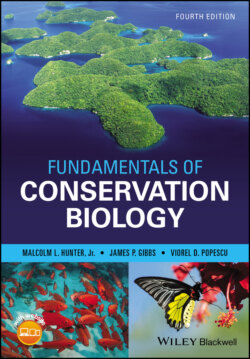Читать книгу Fundamentals of Conservation Biology - Malcolm L. Hunter Jr. - Страница 90
Summary
ОглавлениеThe conceptual definition of an ecosystem is straightforward – a group of interacting organisms and their physical environment – but deciding where one ecosystem ends and another begins can be difficult. Evaluating the differences and similarities among many ecosystems and classifying them into different ecosystem types is even more challenging. Despite these difficulties, recognizing and classifying ecosystems are useful exercises for organizing our understanding of the patterns of ecological interactions.
The value of an ecosystem, at a minimum, consists of the sum of all the values of the species that occupy the ecosystem. Beyond this, the instrumental values of ecosystems are primarily based on services: for example, exporting clean water and other economically valuable functions, providing complex models for research and education, and serving as sites for spiritual renewal. Ecosystems have a critical strategic role in conservation because protecting a representative array of ecosystems will protect biodiversity at the species and genetic level to a significant extent. The idea of ecosystems having intrinsic value revolves around an unresolved controversy: to what extent are ecosystems loosely organized collections of species versus highly integrated systems of coevolved species? The closer they are to being highly integrated, the more likely it is that loss of species could lead to ecosystem degradation. In general, ecosystems with high species diversity are likely to be less subject to degradation (more stable), but this is a complex subject. Many factors influence the relative species diversity of different types of ecosystems such as patterns of energy, water, heterogeneity, size, and more. Maintaining ecosystem diversity also requires maintaining the spatial arrangements in which ecosystems occur; in other words, natural landscapes require protection.
